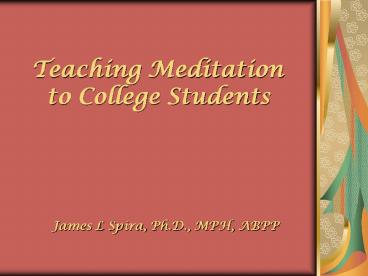Teaching Meditation - PowerPoint PPT Presentation
Title:
Teaching Meditation
Description:
Title: Slide 1 Author: Jim Spira Last modified by: breinhar Created Date: 4/22/2006 9:14:19 PM Document presentation format: On-screen Show Company – PowerPoint PPT presentation
Number of Views:172
Avg rating:3.0/5.0
Title: Teaching Meditation
1
Teaching Meditation to College Students
James L Spira, Ph.D., MPH, ABPP
2
Outline
- Principles of Meditation
- Types of Meditation
- Simple/Effective Techniques
- Adapting to different problems
- Adapting to different settings
3
Principals of Meditation
- Reducing attention to cognitions and reactions to
cognitions and emotions - Reducing focus on and reaction to self and others
and the world - Allowing fuller perception of what presents
itself, more as it is, with less biased
distortion - Being fully and comfortably in the moment
- Calming the mind
- Comforting the body
4
Types of Meditation
- Eastern Experiential vs Western Conceptual
- Yogic Origin
- Pranayama
- Hatha Yoga
- Taoist
- Tai Chi
- Chi Kung
- Buddhist
- Vipassana
- Zen
5
Simple Effective Techniques
- Absorptive Approaches
- Yoga
- Tai Chi
- Zen
- Observational/Non-reactive Approaches
- Vipassana / Mindfulness
- Combination Approaches
- Zen/Mindfulness
6
(No Transcript)
7
(No Transcript)
8
(No Transcript)
9
Respiratory Sinus Arrhythmia (Specific
Frequencies of HRV)
RSA During Worry
RSA During Zazen
10
(No Transcript)
11
(No Transcript)
12
EEG Aspects of Meditation
- Hz attentional focus processing effort/style
- Delta (0-4Hz)
- Sleep
- Effortless, recuperative
- Theta (4-8Hz)
- Daydreaming, background noise
- Minimal effort, parallel processing
- Alpha (8-12Hz)
- Calm, clear open attention to sensation
- Low effort, Bottom-up, sensory processing
- Beta (12-16 16)
- Focused attention to problem-solving task
- Effortful, conceptually-driven processing
13
EEG States of Mind
Snapshots of a normal subject undergoing
different activities (1 lead)
14
Functional Model of Attentional Processing
Elite Athlete
thoughts
associations
Average Person
feelings
ADHD
Attention to environment
Attention/access to internal experiences
Meditator
15
Attention is enhanced processing
- 1) We enhance what we attend to
- Pay attention to worry and we will enhance the
worry - Pay attention to sensation and we will enhance
sensation ( or -) - 2) We become what we attend to
- If we attend to pain or worry, our nervous
systems gear up for that - If we attend to the softness of the breath or the
simplicity of sensory input, our nervous systems
reflect that processing
16
Attentional Retraining
- 3) Pay attention to something if you can act on
it to improve the situation. - Otherwise, switch your attention to
- Some other beta activity you can act on
productively - Rest in alpha receptive meditative state
17
Attentional Retraining
- Two ways to improve attention
- (i.e. enhance S/N ratio for what one
processes) - 1) Reduce Theta (background noise)
- through Vipassana style meditation (low alpha)
- (one typically drifts into theta, learns to
recognize it and let it go, to be replaced by
alpha activity) - this is typically practiced in a meditation
session - CBT may first need to be employed to support
belief in the benefit of suspending self-image,
especially among those who lack confidence in
themselves (NPD, GAD, BN, etc.)
18
Attentional Retraining
- 2) Enhance Alpha (attended signal) through Zen
absorption techniques - A) high alpha
- this can be practiced either in a meditation
practice (eyes open) - or in receptive activities of daily life, such as
driving, walking, eating, listening to a
conversation, etc. (examples?) - B) low beta
- can be enhanced through training in sustained
attention in active involvement - for anxious or ADHD types, being motorically
involved is useful (chi kung, tai chi, Yoga,
doing massage, Karate, etc.)
19
Attentional Retraining
- Those who ignore internal activity need to
emphasize - recognition of internal noise and be less
unconsciously driven by it (Vipassana) - Impulsivity/OCD/Conversion D/O
- Those who are "stuck" in their thoughts need to
emphasize - enhancement of signal (Zen)
- ADHD/GAD/PTSD/Psychosis
- But all need to practice both approaches
- typically practicing both each day
20
Practice
- Active Absorptive ? Still Permissive































